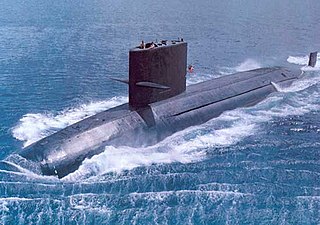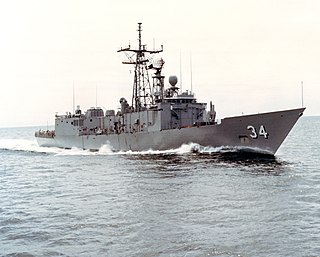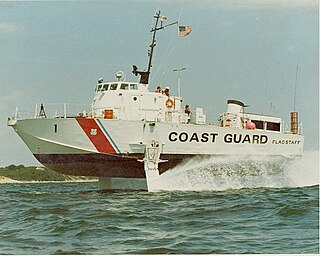
The fifth USS Truxtun (DLGN-35/CGN-35) was a nuclear powered cruiser in the U.S. Navy. She was launched as a destroyer leader and later reclassified as a cruiser. She was named after Commodore Thomas Truxtun (1755–1822). She was in service from May 1967 to September 1995.

USS Antrim (FFG-20) was the twelfth ship of the Oliver Hazard Perry class of guided-missile frigates. She was named for Rear Admiral Richard Nott Antrim (1907–1969).

USS Arkansas (CGN-41) was a Virginia-class nuclear-propelled guided-missile cruiser of the U.S. Navy. She was in commission from October 1980 through July 1998. Her primary missions were in defending aircraft carrier task forces in air defense (AAW) and antisubmarine warfare (ASW) by using her guided missiles, radar systems, and sonar systems. Since Arkansas had the high speed and unlimited range provided by her nuclear reactors, she usually escorted the nuclear-powered aircraft carriers of the U.S. Navy.

USS Bonefish (SS-582) was a Barbel-class submarine of the United States Navy, and was the second U.S. Navy submarine to be named for the bonefish.

USS Barney (DD-956/DDG-6) was a Charles F. Adams-class guided missile destroyer in the United States Navy. She was the third Navy ship named for Commodore Joshua Barney USN (1759–1818).

USS Towers (DD-959/DDG-9) was a Charles F. Adams-class guided missile destroyer of the United States Navy notable for action in the Vietnam War. The ship was named in honor of Admiral John Henry Towers.

USS Galveston (CL-93/CLG-3) was a Cleveland-class light cruiser of the United States Navy that was later converted to a Galveston-class guided missile cruiser. She was launched by William Cramp & Sons Shipbuilding Company, Philadelphia 22 April 1945, sponsored by Mrs. Clark Wallace Thompson. The cruiser's construction was suspended when nearly complete on 24 June 1946; and the hull assigned to the Philadelphia Group of the Atlantic Reserve Fleet. She was reclassified CLG-93 on 4 February 1956; then reclassified to CLG-3 on 23 May 1957; and commissioned at Philadelphia 28 May 1958.

USS Aubrey Fitch (FFG-34), the twenty-sixth ship of the Oliver Hazard Perry-class of guided-missile frigates, was named for Vice-Admiral Aubrey Fitch (1883–1978), who was noted for his outstanding command work in the South Pacific during World War II.

The Pegasus-class hydrofoils were a series of fast attack patrol boats employed by the United States Navy. They were in service from 1977 until 1993. These hydrofoils carried the designation "PHM" for "Patrol Hydrofoil, Missile." The Pegasus-class vessels were originally intended for NATO operations in the North Sea and Baltic Sea. Subsequently, participation by other NATO navies, including Germany and Italy, ceased and the U.S. Navy proceeded to procure six PHMs, which were highly successful in conducting coastal operations, such as narcotics interdiction and coastal patrol, in the Caribbean basin.

USS Pegasus (PHM-1) was the lead ship of her class of hydrofoils operated by the United States Navy. Pegasus-class vessels were designed for high speed and mobility, and carried a powerful armament for their size.

USS Aries (PHM-5) is the fifth ship of her class of hydrofoils operated by the United States Navy. Pegasus class vessels were designed for high speed and mobility. Despite being small in size, they carried a large 76 mm gun. Aries was named for the constellation.

USS Taurus (PHM-3) was the third ship of her class of hydrofoils operated by the United States Navy. Pegasus class vessels were designed for high speed and mobility, and carried a powerful armament. The ship was named for the constellation Taurus.

USS William V. Pratt (DLG-13/DDG-44) was a Farragut-class destroyer in the service of the United States Navy. She was commissioned in 1961 as DLG-13 and reclassified as a guided missile destroyer, designation DDG-44, in 1975. She was named to honor Admiral William Veazie Pratt, a President of the Naval War College and a Chief of Naval Operations.

The third USS Blakely (DE-1072/FF-1072) was a Knox-class destroyer escort in the United States Navy. She was reclassified as a frigate in 1975 along with her entire class. Her primary mission of ASW remained unchanged. She was named for Captain Johnston Blakeley and Vice Admiral Charles Adams Blakely. She was primarily stationed out of Charleston, South Carolina.

HMCS Bras d'Or was a hydrofoil that served in the Canadian Forces from 1968 to 1971. During sea trials in 1969, the vessel exceeded 63 knots, making her the fastest unarmed warship in the world at the time.

USS Badger (FF-1071) was a Knox-class frigate in service in the United States Navy from 1970 to 1991. She was sunk as a target in 1998.

USS Wainwright (DLG/CG-28), a Belknap-class destroyer leader, was the third ship of the United States Navy to be named for members of the Wainwright family; specifically, Commander Jonathan Mayhew Wainwright, his son, Master Jonathan Mayhew Wainwright, Jr., and his cousin, Commander Richard Wainwright, as well as Rear Admiral Richard Wainwright, the son of Commander Richard Wainwright, and Commander Richard Wainwright, the son of Admiral Wainwright. Her keel was laid down on 2 July 1962 at Bath, Maine, by the Bath Iron Works Corporation. She was launched on 25 April 1965 sponsored by Mrs. Richard W. Wainwright; and commissioned on 8 January 1966 at the Boston Naval Shipyard.

The USS Tucumcari (PGH-2) was a Boeing-built hydrofoil. Named after Tucumcari, New Mexico, it was the basis for the technology used in the subsequent Pegasus-class patrol boats and the Jetfoil ferries. Its unique feature was a waterjet propulsion and a computer-controlled fully submerged foil configuration of one foil at the bow and foils on the port and starboard sides. The Tucumcari was one of two prototype boats contracted by the Navy under project SCB 252 for the purpose of evaluating the latest hydrofoil technology. The second boat was the rival Grumman-built USS Flagstaff (PGH-1).

USS Flagstaff (PGH-1) was the only Flagstaff-class patrol gunboat (hydrofoil) and was acquired by the United States Navy because of her relatively low cost and very high speed. She was later loaned by the Navy to the U.S. Coast Guard, as USCGC Flagstaff (WPBH-1). The Coast Guard’s interest in the craft was the craft’s speed and its ability to interdict smugglers and other suspicious craft approaching the U.S. coast.

USS Beacon (PGM-99/PG-99) was an Asheville-class gunboat in the United States Navy during the Vietnam War. She was transferred to the Hellenic Navy where she serves as PG Hormi.


















